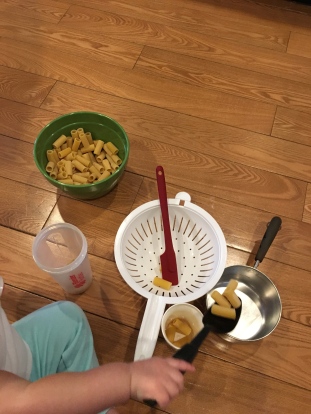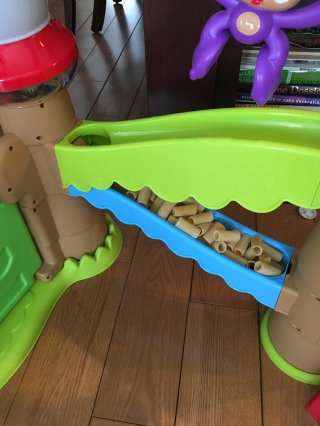Upon returning home from grocery shopping one evening, my three-year-old was running around the house with a box of noodles looking for something.
Dr. Dad watched him in confusion and finally asked, “are we going to eat those noodles?”
OT mom said, “Probably not.”

Our son was looking for the laces that go to his lacing card activity set. You can tell he hangs out with his OT mom a lot, as he views this food as so much more than potential dinner. There are just so many fun things that you can do with a box of noodles besides simply eating them. My three-year-old was one the right track when he was looking for his the laces to his lacing cards, which brings us to our first activity.
(Please keep in mind, though, that many young kids will try to put dry noodles in their mouth, so always keep them under close supervision. Some types of dried pasta can also break or crack leading to sharp edges).

1. Lace/string them. This activity promotes a lot of great skills, including bilateral coordination and fine motor control. Prior to learning to write and before little hands can complete advanced fine motor skills, some prerequisite abilities are needed, such as strength, coordination, and the ability to utilize a variety of grasp patterns efficiently. This activity includes the need for more mature grasp patterns (such as the pincer grasp and three-jaw-chuck) and encourages wrist extension (also needed in for higher level fine motor skills, including writing) and challenges visual motor skills. You can make this activity even more educational by including patterns to the stringing or practicing counting while stringing.

2. Sort them. You can do this a couple different ways: using visual and/or tactile discrimination. Learning to sort is a great activity for young kids. It teaches children to recognize similarities and differences. You can make this a fun game by having kids rely on only their tactile sense to discriminate different kinds of pastas (a sense known as stereognosis). To do this, occlude your child’s vision from the bowl of pasta and have them try to identify the different shapes without seeing them.

3. Use pasta in a sensory box! Sensory boxes are a great and quick activity go-to. You can use smaller pastas for activities that are similar to those you could do in a sand box or rice box. Adding different textures or sizes of noodles can be fun, or just one unified kind can be used as well. I really like giving my kids little cups and spoons so they can scoop, pour, and stir the noodles. If you really think about the ability to be able to accurately pour and scoop, there is a lot going on. You practice your proprioceptive sense to adjust the right muscle force as to not throw the pasta across the room. You use visual motor skills to be able pour directly into what you intend to. You get a lot of sensory feedback from the restriction of the noodles as you stir and move them and you can hear them rattle around as you are doing so. Kids just love it, and there’s a lot they gain from it.

4. Glue them/use them as an art medium. My kids love art and sometimes it’s great to break away from the usual crayons and markers. I remember making macaroni pictures as a kid, and years later my own kids still embrace this classic activity. Not only is creativity engaged, but once agin fine motor manipulation of the small piece is needed and practiced. You can find tons of ideas online (try pinterest) or let your kids free style it. Above is the one we came up with this week.

5. Use them as an art tool. Who needs a paint brush, when you have a noodle? Well, we had a bunch of rigatoni noodles hanging around and I thought that the circular shape would be fun to make four leaf clovers for some St. Patrick’s Day crafting. I thought they turned out looking like clovers, but my son called them “butterflies.” I think that works too! We also made caterpillars and flowers. The most fun part was that the paint made little paint bubbles most of the time we “stamped” with the noodles.
6. Learn with them. Why not use a multi sensory approach to learning with noodles? You can line them up to learn letters or build a person to learn body awareness and body concept. My son liked counting out the right amount of noodle pieces for two eyes and ten fingers. You can make and copy patterns to work towards early math skills. You can play a visual memory game in trying to recall what kind of pastas were on a tray after having your kids look at them for a minute then taking them away. The options are as endless as the noodle varieties.
7. Pretend with them. Pretend play is an important area of play and contributes to social emotional development for kids, and pasta is an easy tool to let their imaginations run wild. I have an old blender that I often pull out (NOT including the sharp parts) as well as some bowls, spoons, whisks, etc. to allow my kids to “cook” in the kitchen while I make dinner.

8. Stick them in play dough. This sounds simple enough, and it is. Pushing the noodles into play dough strengthens hand muscles that will be necessary for writing and other self care and fine motor tasks young kids need as they develop. You can also hide smaller noodles in the play dough for a sort of dig and find game.

9. Shake them up! What kid doesn’t like to make noise? I think I remember doing something similar with beans as a child. Noodles work just as well. Find some kind of old cup or container (we used a couple plastic take and toss cups) and pour some noodles in. Cover the end with wax paper or parchment paper secured with a rubber band and shake away. This activity can get your kids up and moving and I think it’s just more fun to make your own toys sometimes. We used two different kinds of pasta shapes, and talked about the subtle difference in sounds each shaker had.
10. Free play. I was just about out of noodle ideas whey my kids came up with their own. My son decided to use them in place of the balls that came with an activity play set involving ramps. He found that the noodles slid down the ramps just fine, and he could jam enough of them in the toy to kind of line them up. This activity actually kept him entertained for nearly 45 minutes (Dr. Dad was impressed). My younger child usually prefers sticking them in cups and empty bottles but also joined her brother in the slide the noodle game. Either way, free play allowed them some unstructured kid time to just explore this item and see how it interacted with their environment. How fun is that?

What might be the best thing about all of these ideas is that noodles are super cheap. So even if you don’t end up eating them, why not try something fun with a box dried pasta goodness? A lot of these activities you can use with other household goods, like rice, dried beans, cereal, etc. I like using pasta since it’s a little less messy than rice and my youngest seems less likely to eat it than things like beans that could be mistaken for candy, etc. If you have even more ideas, use your noodle and leave a comment! 🙂
*Disclaimer: The information presented in the blog is intended for information and entertainment purposes only. Please consult your physician with any medical concerns and/or for medical advice. The information presented is not intended to be used in place of individualized therapy services, please contact your health care team for skilled therapy if you think it is necessary. Please supervise your children (or friends, spouses, etc) if you decide to try any of the activities or ideas presented as the author or this blog does not claim liability for possible injury or negative consequences related to the activities and ideas presented here.









Pingback: Messy Play Hacks | OT Mom Says
Pingback: Touch: A Multi-Sensational Feeling | OT Mom Says